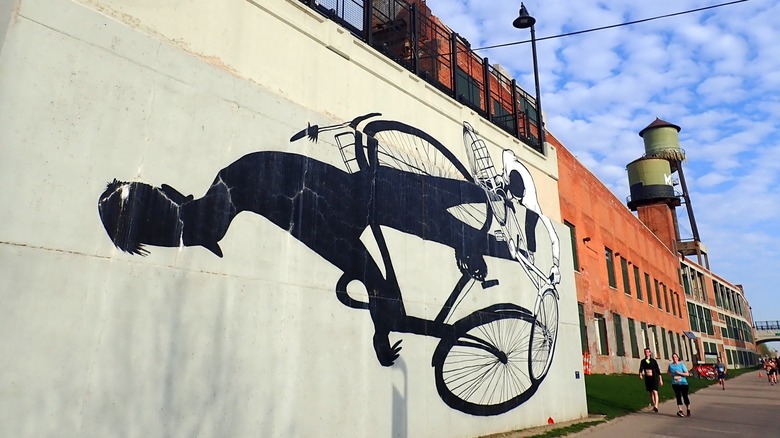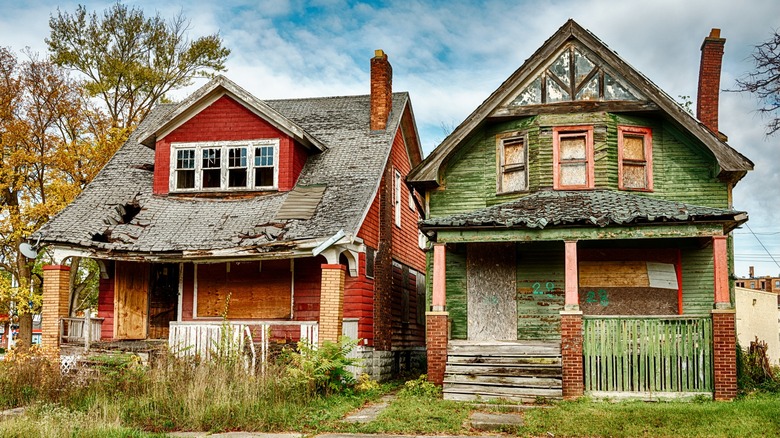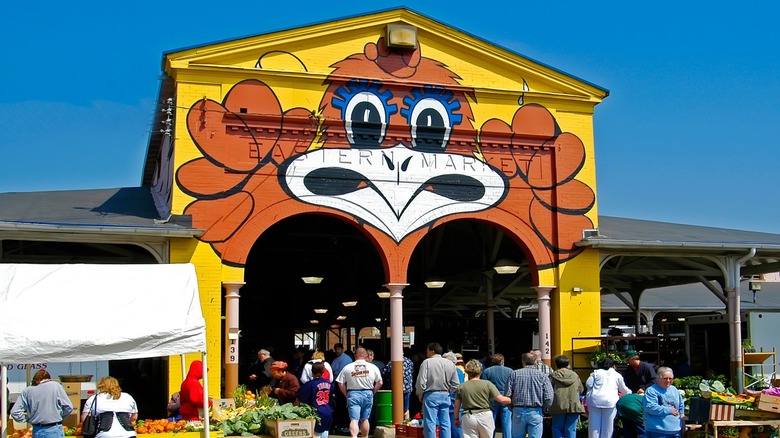The Midwest Spot Vying For The Title Of Best New Art City Thanks To Its Affordability
The thriving, cheap, and creative reputation of New York City in the 1970s, Portland in the '90s, or Los Angeles in the 2010s might now be moving to the Midwest. Between Cincinnati's title as the American street art capital and art havens of Michigan's small towns, the region is teeming with artists trying to escape skyrocketing coastal real estate — a buzzkill for any starving artists' practice. Many of those artists have landed in Detroit. But the creative ecosystem there didn't develop overnight.
A longtime home to the U.S. auto industry, Detroit reached its population peak of almost 2 million people in 1950. Since then, the industry's outsourcing and factory decline, along with poor city management and statewide recessions, have whittled away the population for decades, leaving thousands of abandoned homes and factories in its wake. Detroit's abandoned infrastructure became a destination for "ruin porn" photographers, graffiti artists, and fire chasers in the 2010s, after iconic street artist Banksy went on a tagging spree in some of the city's dilapidated factories in 2010.
In 2013, the city became the largest municipality in the nation to file for bankruptcy; since then, its comeback has been led by the renegade artists whose studio space, maker-culture, and creative output have enticed developers to invest in Detroit and turn it into a vibrant art-lover's paradise. The current population of just over 600,000 saw its first year of population growth since 1957, adding almost 2,000 residents in 2023, according to census data.
Low-income residents and artists are looking for affordable options
The exodus from Detroit over the past half century left a glut of abandoned houses in its wake, reaching fever pitch after the 2013 city bankruptcy. Many of those houses were broken into, stripped, burned, and left to rot; others maintained their charming facade and bones, and just needed a little love.
A nonprofit arts organization, Write-a-House, even awarded low-income writers free (abandoned and foreclosed-on) houses, in exchange for a two-year commitment to move to the city, boost its arts scene, and pay property taxes. Writers who chose to stay after the residency would receive ownership of the house. The organization was short-lived, but abandoned houses are like catnip to artists. They understood the opportunity Detroit presented to affordably own property or rent studio space in an unique art-lover's paradise. In addition to die-hard local artists, some intrepid transplants began to put down roots.
Detroit has continued to make an effort to maintain affordable housing for artists and other low-income residents as the city makes a comeback post-bankruptcy. Mayor Mike Dugan secured a $30 million federal grant to create affordable housing in Corktown, a neighborhood that has been leading the revitalization. His plans for affordable housing in the neighborhood would secure a new 600-unit Corktown building where low-income residents could be paying $200 – $800 a month. "That's a pretty remarkable deal," Duggan told CBS News. It's the least the city can do for residents who have stuck with it through the tumultuous times of its past, and fueled its regrowth with their creativity and culture.
Little Village and Corktown show the two sides of the Detroit art scene
The oldest neighborhood in Detroit, Corktown, has proudly become a thriving artsy neighborhood at the center of revitalized cool. Its mix of historic homes, local businesses, and art spaces sit on the west edge of downtown Detroit, flanked by the old Michigan Central Station. A premier Corktown hotel, Trumbull & Porter, features the work of Detroit-based artists on interior and exterior murals, as well as hosting gallery installations at its 1331 Trumbull Street hotel. At Corktown Studios on 2707 14th Street, an artist collective provides affordable studio space and exhibition halls for its member artists, with frequent public shows. Meanwhile, the Corktown Cultural Center at 1430 6th Street welcomes visitors to explore local history from a Corktown perspective in a participatory experience.
On the other side of downtown, a new artist district in the East Village, called Little Village, made a grand entrance in 2024. Longtime Detroiters Anthony and JJ Curis, who have spearheaded gallery projects downtown, like Library Street Collective gallery and dining alleyway at 1274 Library Street, are passionate about using Detroit's newfound cultural cache to support the artists who have made revitalization possible. Little Village surrounds two architectural landmarks: a rehabbed 1911-built church now known as the Shepherd (1265 Parkview Street) and the Little Village Library. Both will host curated exhibitions, performances, and installations from local artists. Outside the Shepherd, the Charles McGee Legacy Park honors the work of one of the city's most important 20th century artists. It includes sculptures designed by the artists before his death in 2021.


